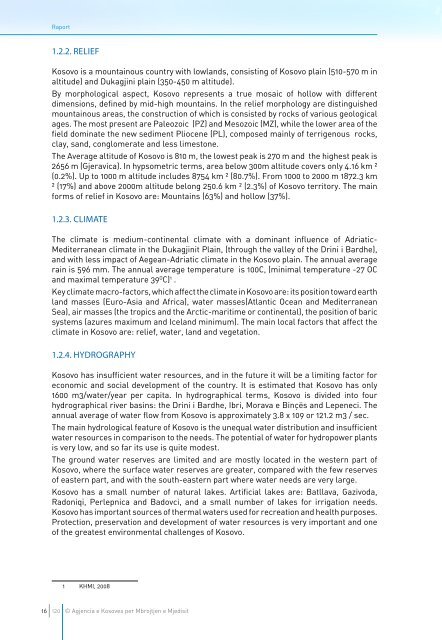The State of Water in Kosovo, 2010
The State of Water in Kosovo, 2010
The State of Water in Kosovo, 2010
- No tags were found...
Create successful ePaper yourself
Turn your PDF publications into a flip-book with our unique Google optimized e-Paper software.
Raport1.2.2. Relief<strong>Kosovo</strong> is a mounta<strong>in</strong>ous country with lowlands, consist<strong>in</strong>g <strong>of</strong> <strong>Kosovo</strong> pla<strong>in</strong> (510-570 m <strong>in</strong>altitude) and Dukagj<strong>in</strong>i pla<strong>in</strong> (350-450 m altitude).By morphological aspect, <strong>Kosovo</strong> represents a true mosaic <strong>of</strong> hollow with differentdimensions, def<strong>in</strong>ed by mid-high mounta<strong>in</strong>s. In the relief morphology are dist<strong>in</strong>guishedmounta<strong>in</strong>ous areas, the construction <strong>of</strong> which is consisted by rocks <strong>of</strong> various geologicalages. <strong>The</strong> most present are Paleozoic (PZ) and Mesozoic (MZ), while the lower area <strong>of</strong> thefield dom<strong>in</strong>ate the new sediment Pliocene (PL), composed ma<strong>in</strong>ly <strong>of</strong> terrigenous rocks,clay, sand, conglomerate and less limestone.<strong>The</strong> Average altitude <strong>of</strong> <strong>Kosovo</strong> is 810 m, the lowest peak is 270 m and the highest peak is2656 m (Gjeravica). In hypsometric terms, area below 300m altitude covers only 4.16 km ²(0.2%). Up to 1000 m altitude <strong>in</strong>cludes 8754 km ² (80.7%). From 1000 to 2000 m 1872.3 km² (17%) and above 2000m altitude belong 250.6 km ² (2.3%) <strong>of</strong> <strong>Kosovo</strong> territory. <strong>The</strong> ma<strong>in</strong>forms <strong>of</strong> relief <strong>in</strong> <strong>Kosovo</strong> are: Mounta<strong>in</strong>s (63%) and hollow (37%).1.2.3. Climate<strong>The</strong> climate is medium-cont<strong>in</strong>ental climate with a dom<strong>in</strong>ant <strong>in</strong>fluence <strong>of</strong> Adriatic-Mediterranean climate <strong>in</strong> the Dukagj<strong>in</strong>it Pla<strong>in</strong>, (through the valley <strong>of</strong> the Dr<strong>in</strong>i i Bardhe),and with less impact <strong>of</strong> Aegean-Adriatic climate <strong>in</strong> the <strong>Kosovo</strong> pla<strong>in</strong>. <strong>The</strong> annual averagera<strong>in</strong> is 596 mm. <strong>The</strong> annual average temperature is 100C, (m<strong>in</strong>imal temperature -27 OCand maximal temperature 39 O C) 1 .Key climate macro-factors, which affect the climate <strong>in</strong> <strong>Kosovo</strong> are: its position toward earthland masses (Euro-Asia and Africa), water masses(Atlantic Ocean and MediterraneanSea), air masses (the tropics and the Arctic-maritime or cont<strong>in</strong>ental), the position <strong>of</strong> baricsystems (azures maximum and Iceland m<strong>in</strong>imum). <strong>The</strong> ma<strong>in</strong> local factors that affect theclimate <strong>in</strong> <strong>Kosovo</strong> are: relief, water, land and vegetation.1.2.4. Hydrography<strong>Kosovo</strong> has <strong>in</strong>sufficient water resources, and <strong>in</strong> the future it will be a limit<strong>in</strong>g factor foreconomic and social development <strong>of</strong> the country. It is estimated that <strong>Kosovo</strong> has only1600 m3/water/year per capita. In hydrographical terms, <strong>Kosovo</strong> is divided <strong>in</strong>to fourhydrographical river bas<strong>in</strong>s: the Dr<strong>in</strong>i i Bardhe, Ibri, Morava e B<strong>in</strong>çës and Lepeneci. <strong>The</strong>annual average <strong>of</strong> water flow from <strong>Kosovo</strong> is approximately 3.8 x 109 or 121.2 m3 / sec.<strong>The</strong> ma<strong>in</strong> hydrological feature <strong>of</strong> <strong>Kosovo</strong> is the unequal water distribution and <strong>in</strong>sufficientwater resources <strong>in</strong> comparison to the needs. <strong>The</strong> potential <strong>of</strong> water for hydropower plantsis very low, and so far its use is quite modest.<strong>The</strong> ground water reserves are limited and are mostly located <strong>in</strong> the western part <strong>of</strong><strong>Kosovo</strong>, where the surface water reserves are greater, compared with the few reserves<strong>of</strong> eastern part, and with the south-eastern part where water needs are very large.<strong>Kosovo</strong> has a small number <strong>of</strong> natural lakes. Artificial lakes are: Batllava, Gazivoda,Radoniqi, Perlepnica and Badovci, and a small number <strong>of</strong> lakes for irrigation needs.<strong>Kosovo</strong> has important sources <strong>of</strong> thermal waters used for recreation and health purposes.Protection, preservation and development <strong>of</strong> water resources is very important and one<strong>of</strong> the greatest environmental challenges <strong>of</strong> <strong>Kosovo</strong>.1 KHMI, 200816120 © Agjencia e Kosoves per Mbrojtjen e Mjedisit
















